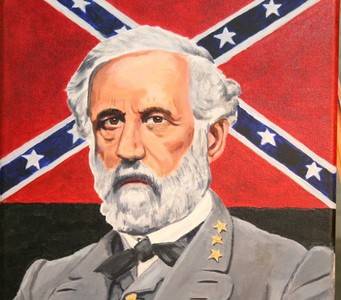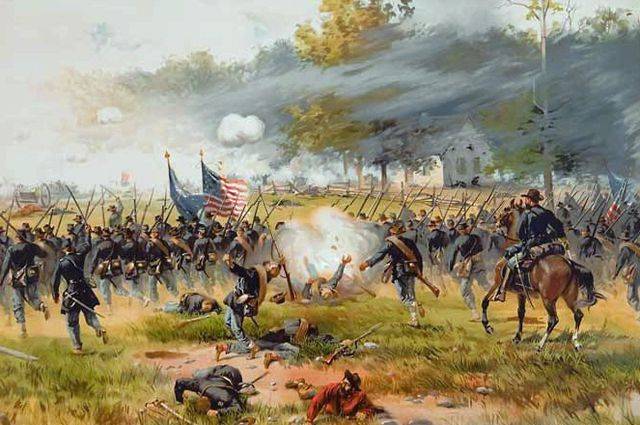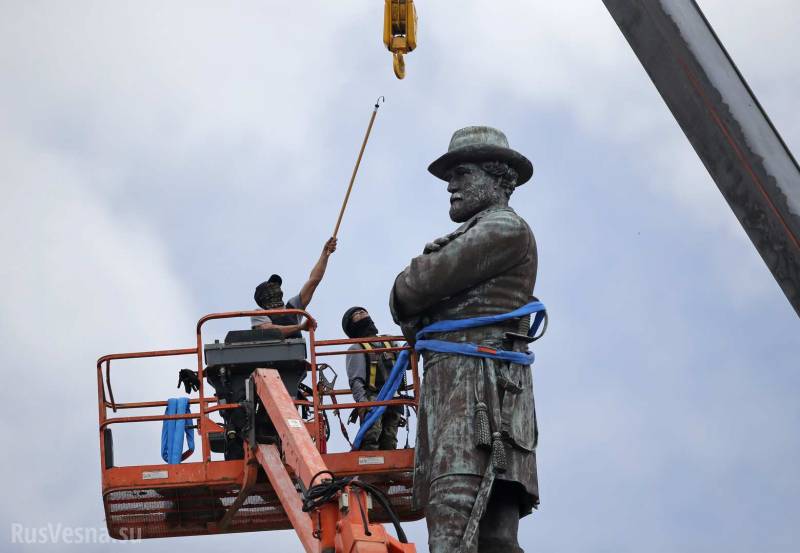General Lee divided the USA. Who was the hero of the Confederation and why in the South are fighting with monuments?
 Robert Lee - one of the most iconic figures in the new stories United States of America. By the way, this year from the date of his birth 210 has turned years. Robert Edward Lee was born in the distant 1807 year, January 19, in Stradford, Virginia. The father of the future General Henry Lee himself was a hero of the American War of Independence and became famous under the nickname "Cavalier Harry". Ann Carter Lee, the commander's mother, also belonged to a prominent Virgin family and was distinguished by intelligence and dedication. These qualities she passed on to her son. Since the father of the family soon had serious financial problems, the mother of Ann Carter Lee was actually engaged in raising her son and maintaining the family. Robert Edward, who had grown up in such an environment as a teenager, began serving as head of the family as a teenager, since his mother’s health had deteriorated, and there was no man in the house. With the financial problems of the family was associated with the choice of further life path of Robert Lee. If his elder brother Charles still had enough money to pay for tuition at the prestigious Harvard University, then by the time the turn to get a higher education came for Robert, the family was already in a bad way with finances.
Robert Lee - one of the most iconic figures in the new stories United States of America. By the way, this year from the date of his birth 210 has turned years. Robert Edward Lee was born in the distant 1807 year, January 19, in Stradford, Virginia. The father of the future General Henry Lee himself was a hero of the American War of Independence and became famous under the nickname "Cavalier Harry". Ann Carter Lee, the commander's mother, also belonged to a prominent Virgin family and was distinguished by intelligence and dedication. These qualities she passed on to her son. Since the father of the family soon had serious financial problems, the mother of Ann Carter Lee was actually engaged in raising her son and maintaining the family. Robert Edward, who had grown up in such an environment as a teenager, began serving as head of the family as a teenager, since his mother’s health had deteriorated, and there was no man in the house. With the financial problems of the family was associated with the choice of further life path of Robert Lee. If his elder brother Charles still had enough money to pay for tuition at the prestigious Harvard University, then by the time the turn to get a higher education came for Robert, the family was already in a bad way with finances. But education was nevertheless required - the noble Virginia family did not want its representative to remain an uneducated person on the sidelines of social life. The only way out of this situation was to enroll in a military school - the glorified military academy of West Point. Robert Lee, who was distinguished not only by diligence in his studies, but also by great physical strength, could well have become an ideal officer in the American army. And he became one. While studying at the academy, Li was one of the best cadets in the academy, not having received a single penalty from the higher command. By the time he graduated from West Point, Lee was the second most accomplished cadet in the academy.
At that time, the cadets, depending on their academic performance and inclination, were distributed among the combat arms. The guys are physically strong, but without expressed interests, were sent to the infantry or cavalry. The "smart men", among whom was Robert Lee, were distributed into engineering troops and artillery - those branches of the military, where deeper knowledge of special disciplines and exact sciences was required. Robert Lee was assigned to the engineering troops and was sent to the Corps of Engineers in the rank of second lieutenant. Almost immediately after graduating from the academy, he participated in the construction of the dam in St. Louis, then in the construction of coastal forts in Brunswick and Savannah.
The young officer settled in Arlington, on the estate of his wife, Mary Ann Kastis, with whom he had married 30 on June 1831. Mary Kastis also belonged to the elite of American society - her father George Washington Park Kastis was brought in by his adoptive grandson to George Washington himself, one of the fathers of American statehood. Robert Lee continued his service in the engineering troops and maybe he would never have moved to command posts in the army if not for the Mexican-American war that broke out in the 1846 year. By this time, the 39-year-old engineering officer was already well known to the command. He was sent to Mexico to manage the construction of the roads necessary for the advancement of the American army. But General Winfield Scott, who commanded the American forces, drew attention to the fact that Robert Lee was not only a good engineering officer, but also an excellent rider, a great gunner and reconnaissance aircraft. A man with such data was very much required at headquarters, so Robert Lee was immediately included among the staff officers of General Scott. Thus began his acquaintance with command and staff duties.
However, after the end of the war, Lee again continued to serve in the engineering forces, which made him very much. First, the career of a military engineer did not give him the desired advancement in his ranks and positions. It was possible to serve all my life in middle-level posts by building roads in remote areas. Secondly, the service in the outback, too, was an officer who could not fully engage his family and lead a normal life. In the end, Robert Lee managed to get a transfer to the cavalry. By this time he was already 48 years old - not the youngest age for a military career. However, it was after the transfer to the cavalry with Lee's career growth that was all right. In October, 1859, he commanded the suppression of the uprising of John Brown, who attempted to seize the government arsenal at Harpers Ferry. Colonel Robert Lee commanded at this time not only cavalrymen, but also marines, having managed to quickly put down the rebellion. By this time, Colonel Lee was already 52 of the year and, quite possibly, he would have ended his service in a colonel's rank, like hundreds of other American officers, if not a civil war broke out soon.

In 1861, the new US president Abraham Lincoln invited Colonel Lee to lead the ground forces of the federal government. By this time, the situation in the country heated to the limit. The southern states, and Lee, as we know, was a native of the South, came into sharp conflict with the federal government. At the same time, Colonel Lee was considered a staunch opponent of slavery and the separation of the southern states from the federal center. Lincoln believed that a talented officer could become a reliable commander of the federal forces. However, Colonel Lee himself made his own choice. He wrote to the US president to resign from military service, stressing that he was not able to participate in the invasion of his native southern states.
A little thought, Colonel Robert Edward Lee turned to Jefferson Davis, who was elected president of the Confederate States of America, offering him his services as an officer. Davis gladly accepted the offer of Lee and assigned him the rank of brigadier general. So Lee was promoted to general epaulets, taking up the creation of a regular army of the southern states. Lee took the post of chief military adviser to President Davis, participating in the planning of many military operations of the Confederate army. Then Lee, who was promoted to full general, led the Army of Northern Virginia. He assumed the position of army commander 1 on June 1862, and soon gained enormous prestige among the confederate forces. Southerners were greatly respected and appreciated by General Lee - not only for his talent as a commander, but also for his excellent human qualities as a sociable and good-natured person.
Under the command of General Lee, the Army of Northern Virginia achieved impressive success, having completed a large number of victories over federal troops. In particular, the army of Lee was able to repel a powerful offensive of the northerners, defeating the army of General Burnside in the vicinity of Fredericksburg. In May, 1863, General Lee's troops were able to inflict the strongest defeat on the Nationans in the Battle of Chancellorsville. Next, Lee embarked on a second invasion of the North, hoping to break through to Washington and force President Lincoln to recognize the Confederate States of America as an independent entity. However, 1-3 July 1863, in the area of the city of Gettysburg, another grand battle took place, in which the troops of the northerners, under the command of General George Meade, still managed to defeat the southern genius Robert Lee. True, General Lee’s troops continued to fight against the Northerners for another two years. Robert Lee earned great respect from his opponents. In particular, Ulysses Grant called him none other than “Ace of Spades”. Only 9 on April 1865. The Army of Northern Virginia was forced to capitulate.
Federal authorities pardoned Robert Lee and allowed him to return to Richmond. The retired general became president of Washington College, and five years after the surrender, October 12 1870, died as a result of a heart attack. Almost until the end of his life, he was engaged in organizing assistance to former soldiers and officers of the Confederation of the States of America, trying to alleviate their fate after a victory for the Northerners. In this case, the general himself was struck in civil rights.
For a long time, the merits of General Lee were recognized not only by Southerners and right-wing supporters, but also by many US patriots, regardless of political convictions or origin. The situation began to change not so long ago, when a “left-liberal” turn took place in the United States, expressed at a symbolic level and in a hard rejection of the memory of all representatives of the Confederation. In the views of the left-liberal circles of American society, the Confederates are practically fascists, ideological opponents and almost political criminals. Therefore, they encounter such an attitude on the part of the American Left.
Interestingly, President Donald Trump himself sharply criticized the decision to demolish the monument to General Lee and to transfer the monuments to other prominent figures of the Confederation. However, as is known, the specificity of the political system in the United States is such that the authorities of a particular state can make decisions of this kind themselves. In the southern states in recent times there have been major changes in political alignments, caused by the increase in the number of non-whites and the acquisition of serious political ambitions by the latter.
After Barack Obama, a man of African descent, visited the US president for the first time in American history, it became clear that the political situation in the USA would never be the same. Representatives of non-European groups of states, including African Americans, immigrants from Latin America and Asia, realized that they could well be a serious political force affecting the political life of the country. On the side of non-white groups were left-liberal US forces, including a significant part of the supporters of the Democratic Party and more left-wing organizations. They also provided informational support, as there are many supporters of left-liberal views among American journalists and bloggers who are trying to influence the mass consciousness of Americans.
The authorities of southern cities believe that they are doing everything correctly, because the monuments are not demolished, but transferred to other places. For example, Lexington, the second largest city in Kentucky, discusses moving the monument to General John Morgan and Vice President John Breckenridge. Both politicians fought on the side of the Confederation of States of America, and this deserved criticism from modern American democrats. The latter substantiate the need to transfer the monument to the fact that it stands on the spot where slaves were auctioned in the 19th century, and thus offended the black population of the city. Slogans in support of the African-American population are increasingly appearing on monuments to American generals. The war with monuments acquired a symbolic meaning for modern America.
Representatives of the American white public mobilized to protect the monuments to the heroes of the Confederation, in the first place - right-wing organizations that are still very strong in the American South. The activities of the American right are associated with numerous attempts to defend monuments and prevent the actions of the left, including through direct clashes. Keep up with the right and their opponents. If the rightists are trying to defend the monuments, the leftists have already turned to acts of vandalism, not waiting for the decisions of the administrative authorities to transfer some of the monuments. So, on August 16 in Knoxville was poured paint on a monument to soldiers of the Confederation of the States of America who died in Fort Sanders in November 1863. The monument was installed in the 1914 year and stood for more than a hundred years before it caused hatred from local left-wing liberals.
In New Orleans, it was decided to demolish all four monuments to the heroes of the Confederation, including the monument to Robert Lee, who stood with 1884 year. It is noteworthy that the monuments were placed shortly after the war, despite the fact that the government was opposed by the Confederates, who shed blood in the fight against them. But they didn’t even raise a hand to desecrate monuments to American patriots, even if they understood in their own opinion the optimal political and social model for the United States. But now many people who have recently arrived in the USA are taking part in demonstrations against monuments. They have never been associated with American history, for them it is - a foreign and alien to them history, alien heroes. The political forces that oppose President Donald Trump and who wish to further implement their own ideas in the United States, consisting in the final erasure of the historical memory of the American people, successfully speculate on the fight against monuments.


Information